Top 30 Backyard Birds
Part I Part II Part III Part IV Part V Part VI
W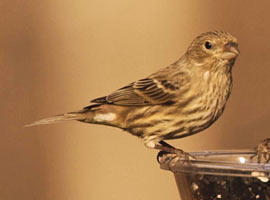 hat birds are in your yard? We’re going to tell you.
hat birds are in your yard? We’re going to tell you.
While different yards in different habitats have different birds, there are some species that are very common and are found around the majority of homes. We’ll be profiling 30 of these most common and noteworthy species over the next 6 months, 5 species each month.
In this first chapter, we start with a (somewhat debatable) Big Five. Most people can see all five of these birds in their yard all year round (the main exceptions are homes in dense conifer forest—you have some different birds). So if you don’t know the name of a single one of the birds at your feeders, read on, and in two minutes you will.
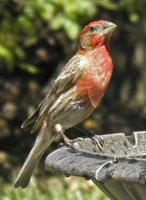 1. House Finch
1. House Finch
The most common and abundant of all feeder birds, house finches come in flocks to feeders offering sunflower seed. They will also eat some suet, peanuts, and Nyjer seed. Males (left) are easily recognized with their bright red head and breast; females (above) are a plainer, streaky brown. Their song is also one of the most commonly heard birdsongs of spring—visit Cornell’s All About Birds to hear it.
Worth noting: Some guides may mention a closely related species, the Purple Finch. Purple Finches are much less common at feeders in our area and generally are found in more natural, wooded habitat. In short: you probably have House Finches rather than Purple Finches. To see the difference, visit this other handy Cornell page.
2. Goldfinches
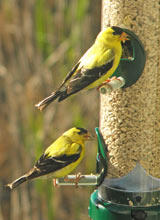 Goldfinches share some traits with House Finches—they hang out in flocks, have musical songs, and eat seed. A little smaller than House Finches, you should recognize them easily as they are the only really yellow bird that visits seed feeders. Feeding goldfinches is often associated with offering Nyjer (or thistle) seed, a tiny black seed that most other birds aren’t that interested in. These days, however, their favorite food seems to be sunflower chips, the edible interior of black oil sunflower and the main ingredient in our No-Mess Blends.
Goldfinches share some traits with House Finches—they hang out in flocks, have musical songs, and eat seed. A little smaller than House Finches, you should recognize them easily as they are the only really yellow bird that visits seed feeders. Feeding goldfinches is often associated with offering Nyjer (or thistle) seed, a tiny black seed that most other birds aren’t that interested in. These days, however, their favorite food seems to be sunflower chips, the edible interior of black oil sunflower and the main ingredient in our No-Mess Blends.
Worth noting: We have two species of goldfinches (Lesser Goldfinches and American Goldfinches), males are generally brighter yellow than females, and birds are brighter yellow in summer than in winter. So altogether, there is a substantial range in what exactly your goldfinches might look like. To dig down a little deeper, see our Goldfinches Page.
|
|
3. California Scrub-Jay
He’s big, blue, has a rather loud and unmusical voice, and loves sunflower, peanuts, and suet. The western counterpart to the eastern Blue Jay (the official bearer of the “blue jay” name is not a species we have here), our scrub-jays are often regarded somewhat harshly as undesirable bullies. Really, they are in the highly intelligent crow family and perform many valuable services, such as warning other birds of approaching predators and caching acorns in the ground for later consumption—the most common way for our oaks to disperse their seeds. To increase your jay appreciation, read our jays' Bird of the Month Page.
Worth noting: In more forested areas, we also have Steller’s Jays, who combine iridescent blue plumage with striking black crests. We’ll cover them later.
4. Anna’s Hummingbird
Our most common hummingbird by far, and the only one that is here year-round. Males have an iridescent red head that may appear almost black as they move in the light; females have a smaller shiny patch on their throat. Anna’s Hummingbirds are easily attracted to sugar water feeders throughout the year, though there is often some slowdown during the spring and summer as blooming flowers and abundant insects provide alternative food sources.
Worth noting: In summer, we do have another species, the Allen’s Hummingbird. They are smaller, have notably cinnamon red sides, and are less common than Anna’s.
|
Anna's Hummingbirds by Ari Friedkin. Click for full size image (female on left). |
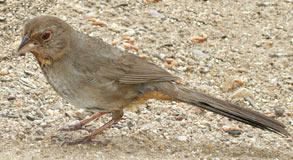 5. California Towhee
5. California Towhee
A pair of dull brown, unmusical, rather clumsy California Towhees is nearly standard issue for a California yard. In some ways they’re rather boring: they have no bright colors, their intermittent metallic chirp sounds like a smoke detector, and they hop around on the ground in the absence of impressive flying abilities. But they’re also rather endearing, inspiring 1920s ornithologist William Leon Dawson to make this comment:
Familiar objects, whatever their worth, come to be dear to us through association. There is, honestly, no particular reason why we should be fond of this prosy creature, save that he is always around. . . . Yet I suppose there are few Californians who would willingly spare the homely, matter-of-fact presence of this bird under foot. Brown Towhees are just birds—the same way most of us are just folks.
Towhees will eat sunflower or millet seed, preferring to feed on the ground or on broad tray feeders rather than small, narrow perches. They are also known for their habits of hopping inside through open doors and for getting into fierce territorial disputes with their reflections in windows and mirrors.
Featured Book: National Geographic Guide to Backyard Birds
First up is the National Geographic Guide to the Backyard Birds of North America. Or, as we call it for reasons of oxygen conservation, Nat Geo Backyard. If you don't intend to look at many birds beyond your yard, it offers a great selection of the birds you can expect to see within it, without all the confusing noise involved in a full-size field guide featuring an additional 800 or so bird species. Read more about this book in our full book review. |


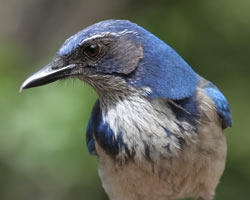
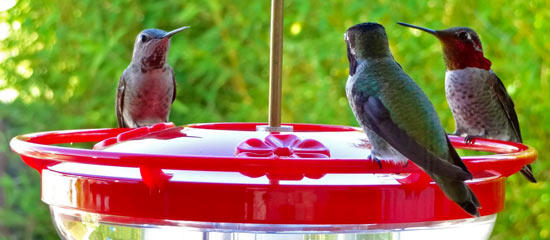
 If you want to get acquainted with the birds in your yard, there are two items that are invaluable: some kind of field guide and a pair of binoculars. As we go through the top 30 yard birds over the next few months, we'll also suggest some books and binoculars that are ideal for people who are just starting to learn their local birds.
If you want to get acquainted with the birds in your yard, there are two items that are invaluable: some kind of field guide and a pair of binoculars. As we go through the top 30 yard birds over the next few months, we'll also suggest some books and binoculars that are ideal for people who are just starting to learn their local birds.